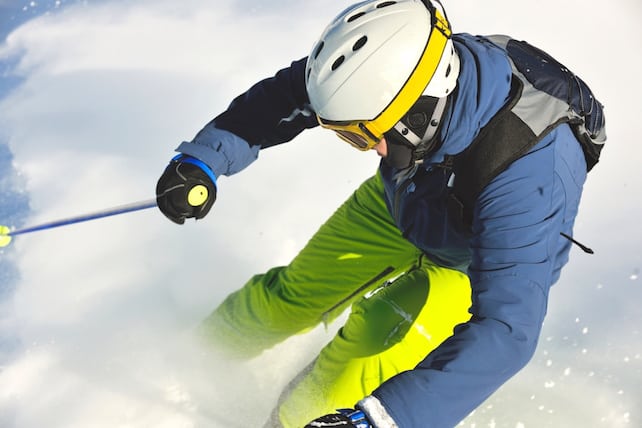
Over the past 30 years Michael Pettifer, MD of ski insurance specialists MPI Brokers, has encountered more than his fair share of head injuries. So what’s his advice on the optimal way to protect yourself when skiing?
Yes I do have a helmet, but I have to admit I was a bit late in the process. I started wearing one four years ago.
There is no question that speeds on the slopes have increased since I started skiing in 1960. In those days, pistes were in their infancy and today’s speeds were just not possible.
I think it is unlikely that we will be forced by law to wear them – too many countries are involved. But I object to the creeping compulsion of some ski policies placing a condition that insured people must wear a helmet. If they do this, what next?
So Should You Wear a Ski Helmet?
Fortunately, at least if you’re an adult, to wear or not to wear is still a matter of personal choice everywhere in the world… unless you happen to find yourself in Ben Eoin, Cape Smokey, Martock, or Ski Wentworth.
These obscure resorts are all in Novia Scotia, the only ski region where – as far as I know – hard hats on the hill for grown-ups are compulsory by law.
But, in my opinion, it must make sense to protect your head, not least because if you collide with another skier and you are one not wearing a helmet your head will be in greater danger.
If I fall and bang my head on the piste, it protects me, and the helmet wearer has a great day-to-day advantage over others – you brush off the unwelcome bang from the bar on chair-lifts, caused by over-enthusiastic companions.
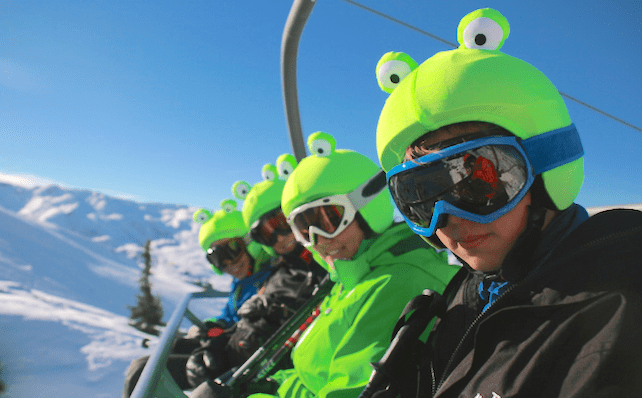
I’m not alone: around 60% of adults and 80% of children in Europe are in my camp. In North America a head count at any lift station will show you that the figure is considerably higher. Yes, I agree that the available data is confusing and that there’s little tangible medical evidence to support the Yes lobby.
Despite a three-fold increase over the past 15 years in the number of wearers, some research shows that the total of head injuries and deaths hasn’t fallen, while others suggest that helmets do limit injuries and do not encourage risk taking.
The Michael Schumacher tragedy doesn’t support the case for either the ayes or the noes, although his doctors have stated that with without one he would most likely have died on the snow.
In the Yes Corner
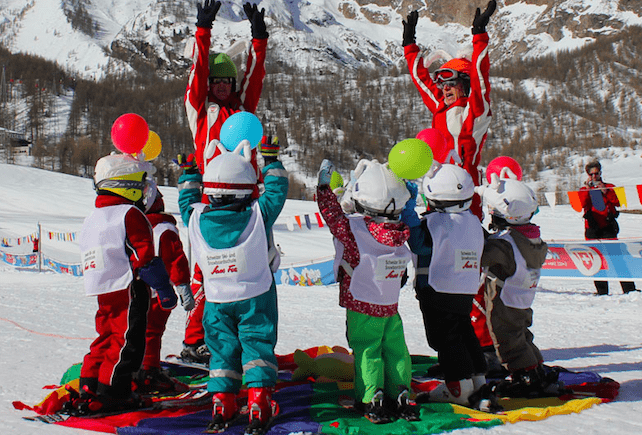
Alan Griffiths, Val d’Isere’s British doctor for 17 years and a leading expert on snowsport injuries, is an adamant supporter: “I’m absolutely behind helmets and haven’t seen anything that would persuade me to think to the contrary.
“If you spent a month or even a day in my surgery, you’d realise that there isn’t any argument.
“Even with people wearing helmets there isn’t 100% protection, such as if you hit a tree at 30mph. However, most injuries take place at slower speeds when helmets can certainly reduce the severity of injuries and save lives.”
In the No Corner
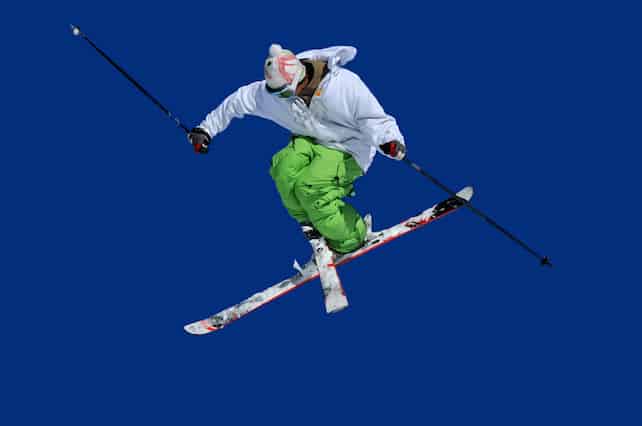
Konrad Bartelski, still Britain’s best downhiller, is vociferously a beanie wearer: “I wear a helmet to race but if I’m skiing for pleasure I want the wind in my hair. If I was forced by law to wear a helmet, I’d give up skiing.”
James Blunt, an avid and expert skier, who raced for the British Army: “When skiing for pleasure, I choose not to. I’m fully aware of the risk I take and the risk is to myself. It’s about being aware of my surroundings and I probably go a little bit slower than I would if I were wearing a helmet.”
Whether you’re already a helmet wearer or are considering buying one, here are the answers to a few of the most common questions people ask…
Is a Helmet More or Less Comfortable Than a Beanie?
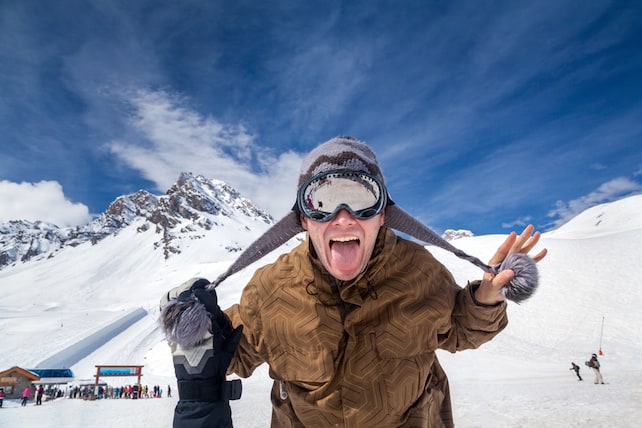
A helmet doesn’t tickle, stays put in a strong wind, is waterproof and adjustable for temperature. If it’s cold I close the vent, if it’s warm I open it, and if its hot in late spring you can always remove the ear pads.
It doesn’t encourage me to ski faster or recklessly. It doesn’t restrict my peripheral vision. Most people say their hearing is no more affected than if they were to wear a woolly hat, but personally I choose never wear the ear pads due to my own hearing restrictions.
Where Do I Have to Wear a Helmet?
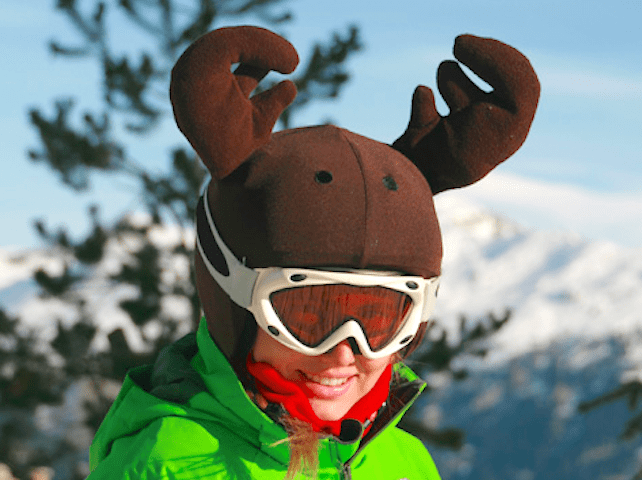
Legally, nowhere (except Novia Scotia, see above) if you are 18 or over. California has legislation in place but successive governors have vetoed it, so at the moment the ‘law’ is unenforceable. Snowparks in some resorts insist on headgear, but there’s no legal requirement. In the 10 resorts owned by Vail Resorts, all instructors and resort staff are required to wear helmets.
For children, it’s altogether a different matter. An increasing number of ski schools and lift companies won’t accept children who are not wearing one – even if the instructor is not wearing one. I think this is a bit like a driving instructor saying ‘personally, I don’t bother with a seat belt, so why are you?’
France and Switzerland have no rules, although the ski schools strongly encourage it. In Italy it’s compulsory up to the age of 14.
In Austria, it depends on where you are skiing: most families from other countries visit resorts in either the Tirol or the Vorarlberg, where there are no rules – or they go to Salzburgerland, where children under 16 must wear helmets. Kids also have to wear hard hats in Upper Austria, Styria, Lower Austria, Burgenland, Carinthia and Vienna.
The helmet regulation also exists for children under 13 in Slovenia. There’s no law in Andorra, Slovakia, Spain or Sweden – although in Sweden children up to seven ski for free if they’re wearing one.
Norway encourages helmet wear but doesn’t enforce it; most children skiing there wear helmets, and now most adults do too. There is no law in Bulgaria but helmet wearing is highly recommended. The rules are not clearly defined in Romania.
In the USA and Canada (Novia Scotia excepted), there’s no legal requirement, but there is cultural pressure – children would look a bit odd without one. In Western Canada, for example, 99.5% of children under 14 years and 81% of all other skiers and boarders wear them. Rules differ among ski schools, for example Lake Louise requires children under 12 years in ski school to wear a helmet.
How Do I Choose a Helmet?
ARVE Error: For the maxwidth (maxw) option you need to have normal or lazyload mode enabled, either for all videos in the plugins options or through shortcode e.g. [youtube id=123456 mode=normal maxw=999 ].
With difficulty, if you try to buy it in a resort shop in the second half of the season. Most of the models on display seem to be size S with a scattering of size M, leading me to the conclusion that most skiers and snowboarders have large heads.
Watch the video above for advice on how to choose your helmet size. It needs to fit snugly and feel comfortable, even when shaking your head. When you align the front of the helmet above the eyebrows, the helmet shouldn’t feel wobbly. Some brands will fit you better than others.
Helmet size is the circumference of your head just above your eyebrows. Don’t buy one that feels too heavy or uncomfortably tight.
Don’t forget to bring along your goggles when you try on a helmet to make sure they fit your face over the helmet. Things to look out for are decent air vents, an efficient goggle retainer clip at the rear. A new type of helmet, such as those from Kask, have integral goggles with interchangeable lenses.
The helmet standards to look for are the European (CE) Standard EN1077 or the American standards ASTM 2040 or Snell RS-98. The European EN1077 standard comes in two categories: A and B. Category A helmets are aimed primarily at ski racers, and are built to withstand impacts at slightly higher speeds, as well as protecting more of the head (notably, the area around the ears).
Increasingly, these helmets also conform to the International Ski Federation’s more exacting 2013 regulations (FIS RH 2013). Most helmets sold to holidaymakers are category B helmets.
Keep an eye for the MIPs system, too, which is incorporated into an increasing number of category B helmets. This allows the helmet lining to rotate inside the shell on impact, absorbing some of the force of the blow.
To help in your research visit Skihelmets.org, which is a US website that will give you an idea of just how vast the choices are when buying a helmet.
How Often Should I Replace My Ski Helmet?
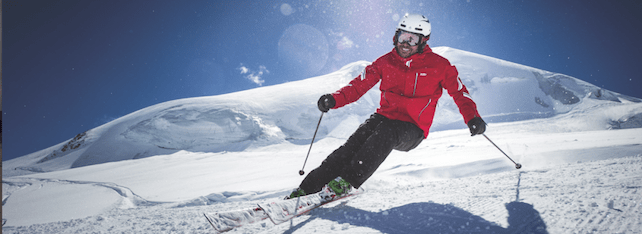
The normal recommendation is every three to five years because the inner foam hardens and becomes brittle, which means there will be less shock absorption in an impact. You’ll need to replace your helmet sooner if you’ve had a crash or if there is damage (such as cracks or dents) to the shell.
Make sure the chin strap is buckled – it’s not going to be much use to you if it falls off in an accident before impact!
Can I Wear a Hat Under a Helmet?
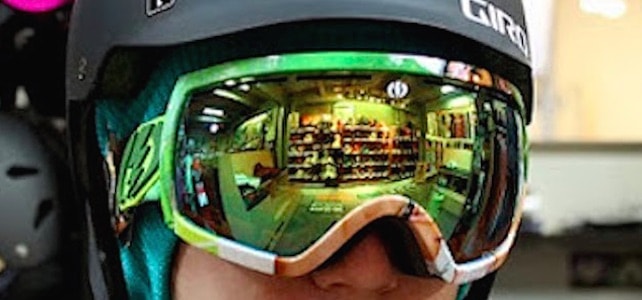
No, the helmet should fit snuggly, and it won’t do so if you’ve jammed a woolly hat underneath. Ski helmets these days are so warm that you won’t normally need to wear anything any extra.
However, on a really cold day you could wear a balaclava specifically designed for helmets or a thin silky liner.
What About Recycled Helmets?

The Hubber Helmet from Picture Organic Clothing is the first eco-friendly ski and snowboard helmet on the market, made entirely out of recycled materials. In other words, 100% of the liner is made out of recycled EPS (Expandable Polystyrene) collected from Japanese car companies. The outer shell is made from PLA (polylactic acid), a polymer derived from corn, which is a renewable resource. And finally, the ear pads are made of recycled polyester. You certainly can’t complain about that!
Can I Wear My Ski Helmet On the Plane?
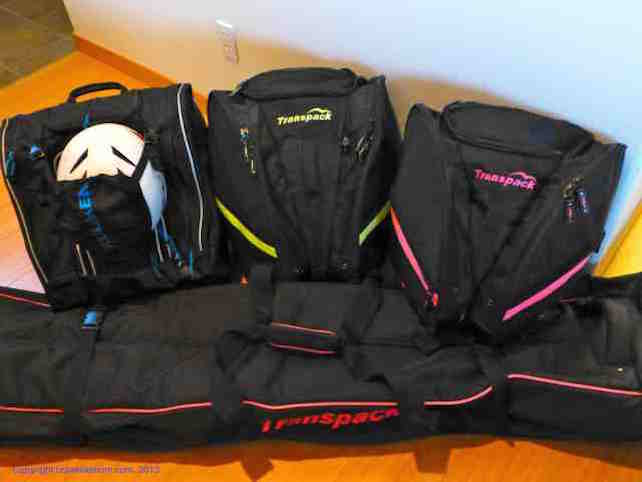
A bit like wearing ski boots – it’s a bad idea! Packed at the bottom of a bag, your helmet can be filled up with goggles, ski gloves and socks. But if you really can’t fit it inside your luggage, then strap it onto the outside of a rucksack and you shouldn’t have a problem going through security at the airport.
Can I Wear a Bike or Motorcycle Helmet for Skiing?
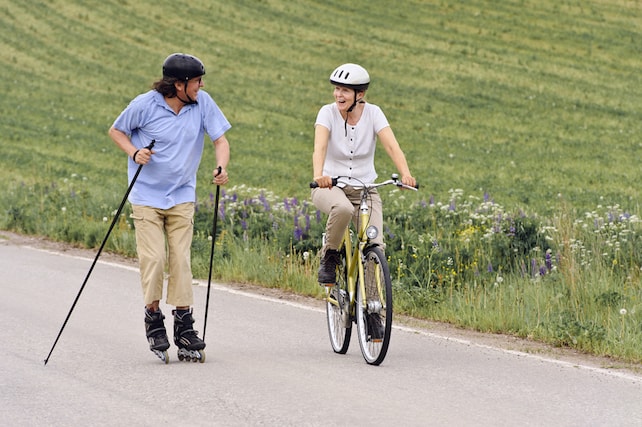
No, bike helmets are too light for the speeds at which you may travel downhill and motorbike helmets are too heavy for the job. There’s a ski helmet to suit everyone and an adult one will set you back from £25 to £300, depending on the materials used.
Are There Any Benefits to a Full-Face Helmet or Chin Guard?
ARVE Error: For the maxwidth (maxw) option you need to have normal or lazyload mode enabled, either for all videos in the plugins options or through shortcode e.g. [youtube id=123456 mode=normal maxw=999 ].
Avoid them. Slalom racers wear helmets with a chin guard to protect them when they hit gates, which can spring back into their faces.
The video above shows Lyndsey Jacobellis, who wore a full-face helmet when she competed in boarder cross at the 2006 Winter Olympics in Turin.
However, for holiday skiers and boarders these have been linked with a higher risk in neck fractures, as they can dig into the snow when you fall over.
Can I Buy a Helmet For My Child to Grow Into?
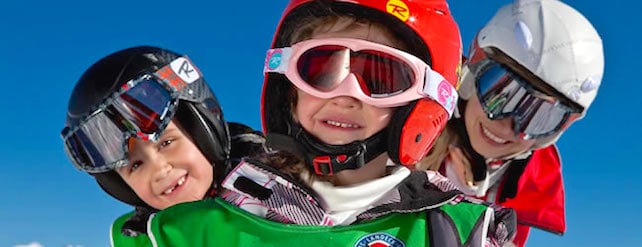
No, children’s heads are much more vulnerable than adults’ and, unlike adult heads, they don’t remain the same size. It is therefore really important that the helmet fits properly for all ages.
Children are also more likely than adults to jump – either on piste, or at the edge of the piste – and teenagers often find it hard to tear themselves away from the jump parks! For these situations, consider getting other types of body armour as well.
Can I Rent a Helmet in the Resort?
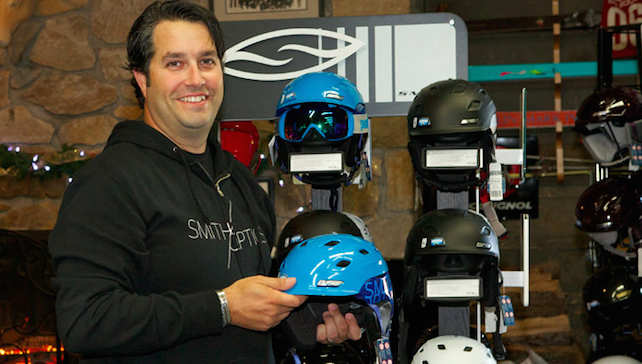
Yes, most resort hire shops have a rental stock for adults and children. If you don’t own one yourself, a rental helmet should be better than no helmet at all. However, the shape may be wrong and do you really want to use a helmet that’s been on lots of other sweaty heads?
So, if you’re thinking of buying a helmet for the first time, bear in mind Dr Alan Griffiths’ advice: “Wear a helmet, but ski like you haven’t got one on”.
What Do You Think?
Follow the advice above, and you’ll have a much better idea of why you should or should not wear a ski helmet, and how to buy the right one.
Do you and your family wear ski helmets? Should there be a law to make sure we all do? Let me know what you think in the comments below.










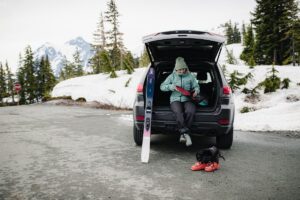


Someone ran into me while I was in the lift queue 5 seasons ago and I hit the back of my head on icy snow. I was out for the count for about 30 seconds according to my wife. I was groggy for a day or two after and had a stiff neck for the rest of the week. If I’d had a helmet on I probably would have been OK.
Having said that I only started wearing a helmet this season after skiing for another 4 years without one. I only changed my mind after last year witnessing my mate split the back of his head open in exactly the same accident I had, an out of control speed freak clattering him in the lift queue.
I didn’t learn until I saw the outcome of not wearing one on someone else.
That’s a very sobering story Richard, and doubly supports the argument for wearing a helmet.
I have worn a helmet for many years and felt inspired to write a ‘tongue in cheek’ article about it. I hope it helps inspire some people to ‘lid up’ who aren’t influenced by the safety aspect:
https://snowboardingholidays.net/gear/why-i-wear-a-helmet-snowboarding/
Only point i would make is nearly every helmet i have tried (if it is the right size) has fitted me fine and I have never had a problem finding one – and I am big headed…
We enjoyed your extra reasons for wearing a helmet: “I don’t have enough to carry”, “Somewhere to put stickers” and “Somewhere to put my gloves”! We hadn’t thought of those!
I am always skiing with helmet and I think helmet is great piece of ski equipment but should be optional not mandatory like in Canada. Helmet is becoming quite usual with younger generations because you can easily mount your cameras on top of helmet and it’s actually quite convenient to ski with helmet.
Only Canadian ski resorts in NS are currently listing helmets as mandatory piece of ski equipment. I found this quite funny when I was in Martock…Ski Martock is basically short hill with 2 slow ski lifts and few short greenish slopes, but still folks in Martock are “serious about snow” but OK after all it’s Canada – respect their snow & winter!
Beware of wearing a camera mount on a helmet, Albert. There’s an argument that in an accident this could change the physics of the helmet and cause it to fracture.
Thanks! I wasn’t aware of this…. will do some google-ing on this
Could you expand on that please? I’ve always worn a helmet (skied for 15 years including working a season). Last ski holiday I attached a camera along the side of my helmet (fixed on my goggle strap), first time I’d tried it. I had a fall and suffered quite severe concussion following it (I don’t remember the entire day, including heli off the mountain). Having never had a serious injury while skiing before I’m wondering whether this was just a really bad coincidence or if the camera reduced the effectiveness of the helmet.
Hi Richard, sounds like it was a pretty serious injury that would have much worse if you had not been wearing a helmet. Because the helmet was undamaged I can’t see that in this case the camera could have had any effect.
Two reasons I don’t usually wear a helmet – they’re not as comfortable as a beanie (nothing anyone says on that will convince me otherwise); to annoy the sanctimonious skiers and boarders I meet on the hill who make patronising comments about the fact I choose to exercise my right to ski without a helmet!
If resorts other than those in NS start to make helmets compulsory I simply wouldn’t ski there.
PS I never thought I’d be a fan of James Blunt but I’m behind him on this one!
Everyone is entitled to their opinion, Alf!
Some of the arguments against wearing a helmet sound eerily like what was said about wearing seat belts….For me, I feel uncomfortable not wearing a seat belt, and now, I feel uncomfortable not wearing a helmet. As for the actual sensation of both: you will forget you’re wearing either if they are properly adjusted.
Yes it does sound a lot like the seat belt debate in the 70s and 80s. Like you, I don’t even notice I’m wearing a helmet.
Last season I bought a Bolle helmet with visor – as a wearer of glasses it’s a godsend. I have never got on with goggles and can’t use contacts so is the perfect solution, and has interchangable visors for bad visibility.
They sound like a good solution for glasses wearers, Helen. For anyone interested, here’s a link: https://wl2s.co/1GznUq6
I had a really nasty bang to my head without a helmet, the same day that Natasha Richardson died, it gave me a wake up call. Have worn one ever since, would much prefer not too, agree with the ‘wind in the hair feeling’ however, if it saves my life it’s a no brainier…literally!
Doesn’t sound much like the seatbelt debate at all to me! Seatbelts have clearly been shown to save lives; ski helmets haven’t
I am not surprised it gave you a wake up call, Maureen, and I’m glad you were ok.
Surely enough I wear a helmet for a few years already, and I don’t consider skiing without one. But to be honest, aren’t head impacts very rare if you ski on the piste, as most of us do, and don’t don’t do jumps at snow parks or off piste between trees and things like that? I fall of course every vacation, but never hit the head (thank god!), except a gentle touch at the snow, and also watching other skiers – other parts such as the knees or shoulders seem more vulnerable. Even if other skiers hit you, as it happened to me, more likely that shoulders / chest / back will take the damage rather than the head. Nevertheless I do recommend anything that would reduce the chance of injury, even if rare.
Excellent article, excellent debate Michael – but I don’t see Italy mentioned. Don’t the Italians have some ruling about children under 14 having to wear them? As for Konrad – my ambition is to get him wearing one (no chance I fear). And his ambition is to get me breathing properly when I ski ! (I’m working on it!) Arnie Wilson – helmet wearer.
It’s there Arnie! Look under the heading ‘Where Do I Have to Wear a Helmet?’ – it’s in the 3rd paragraph after France and Switzerland.
Had a quick re-read but not sure if I’ve missed it like Arnie, and almost as obscure as Nova Scotia in skiing terms, BUT New Jersey in the US passed a law in 2011 that children up to age 17 must wear helmets I understand: https://www.mountaincreek.com/upload/photos/487HelmetLaw.pdf
Also as a slaphead, I DO find helmets better than beanies as I experience brain freeze at speed against a cold wind which is quite painful, but the plastic helmet protects me from that. It has also saved me a few times when, ahem, ‘foolish people’ have swung skis over their shoulders at the end of the day without checking who’s near them, so I’d recommend keeping it on until your back in the hotel room, maybe even in the bar at night…
We didn’t know about the law in New Jersey, so thanks for letting me know Patrick. Agree with you about foolish people swinging skis over their shoulders – the same applies to people pulling down the bar on chair-lifts before everyone else is ready. When the bar hits me on the head I’m always grateful that I’m wearing a helmet!
I used to love not wearing a helmet being a boarder it was fantastic. Until my husband suggested 4 years ago I should because of our daughter (setting an example). I have just had a fall 1 week ago where I was not going fast, on a blue, run no ice just a freak accident. I caught an edge and landed on the back of my head. Snow patrol had to bring me down the mountain I had to go to hospital for x rays. My helmet was smashed and cracked in 4 places. I am still in shock 1 week later at the fact if I had not been wearing that helmet I may not be here today. It may seem like an exaggeration but this was a huge eye opener for me. I know I’ve had bad falls before but to see that helmet cracked open like a boiled egg. It should be made law in all countries (for at least under 16s) to wear helmets..
Hi Lynda, so sorry to hear about your accident, but we’re pleased that the helmet helped minimise your injuries. All three of our editors started wearing helmets for the same reason as you did – to set an example to our children – and we are pleased we’ve done so. We completely agree with you about the under-16s. My children now wear spine protectors as well (see our feature on keeping safe).
I find that goggles fit much better over my glasses when I wear a helmet. Now I have got used to wearing it, it feels unnatural when I take it off. I was also wiped out by a reckless skier and banged my head on the ice quite hard. I was fine afterwards.
We agree, it now feels strange not to be wearing a helmet!
What are your thoughts on an adult wearing a junior helmet? I have a small head and the adult smalls didn’t quite fit well. They were still big on me. A youth medium fits perfect. Is there any difference in the way the helmets are made?
No difference – if it fits and is comfortable. You haven’t mentioned the make – but check that the helmet complies with the European Standards and, if it does, than go for it.
When helmets 1st came in I thought they looked silly, however the more accidents I saw on ski patrol.. I decided to wear one.. It keeps me warm in the cold, stops people bashing me on the head with the bar on the chairlift
We revived a girl who hit her head on the ice, and if ski patrol wasn’t right next to her she may not have made it..
Stop being the hero ! There is not one skier who hasn’t had a fall. Also seen people cut their head on their skis which a helmet would prevent..
Sure there is no test to prove that a helmet will save your life, however when you see a helmet cracked like an egg.. it’s better than you own head.
Ridiculous that’s it’s compulsory for kids when adults ski faster and are often more reckless !!
Why wear one when you are young then take it off as you get older.
Helmet use is, and should be, a personal choice. I wore one when I used to race, but do not when skiing recreationally. This is an area where people should be able to decide for themselves.
FIXED VISOR HELMETS v HELMET & GOGGLES >> ??…
I am not a glasses wearer and see many pro’s and con’s with both, is there anyone who isn’t sitting on the fence like me with this and have used both and can recommend which way to go? Struggling to find any advice on the matter… and must purchase before my trip in Feb 🙂
Thanks!
I am absolutely devastated that we do not have a helmet law or requirement. Two days ago while skiing with a friend she died instantly on the mountain from head trauma. She was an accomplished PSIA skier, has skied at least 40 years of her life, was a ski instructor and that day she decided not to wear her helmet because it was a Monday and the mountain wasn’t very crowded. The run she was on was a run she probably has skied a thousand times. She skied almost everyday. Unfortunately another skier clipped her ski and she fell. She took one ski off in order to stand up, slipped and slid down the run and off the edge. She fell about 15 feet into rocks and tree stumps and whatever else was down there. I have never witnessed anything so tragic in my life. I stayed with her while she tried to stand up but the run was so steep and everything happened so fast that I’m devastated that I couldn’t save her. I would donate my time to try to get a law passed but according to everything I read the fact that it infringes on a person’s freedom of choice it doesn’t look like it will ever happen. I’m so sad for the lives that will be lost because of that.